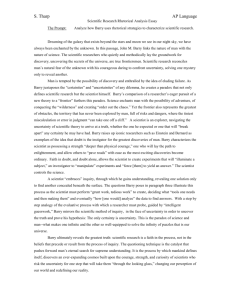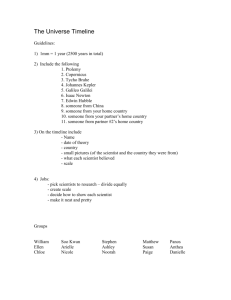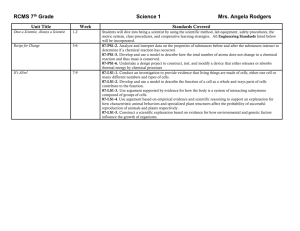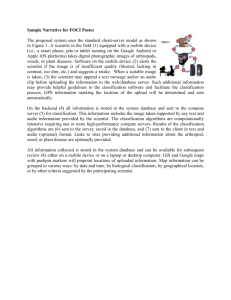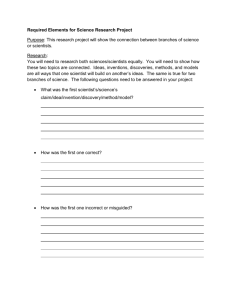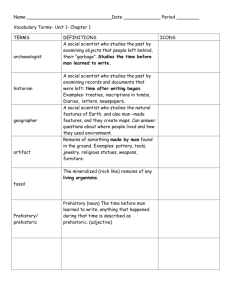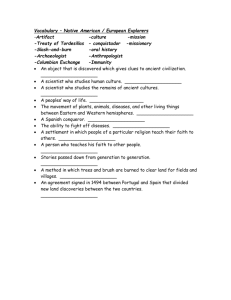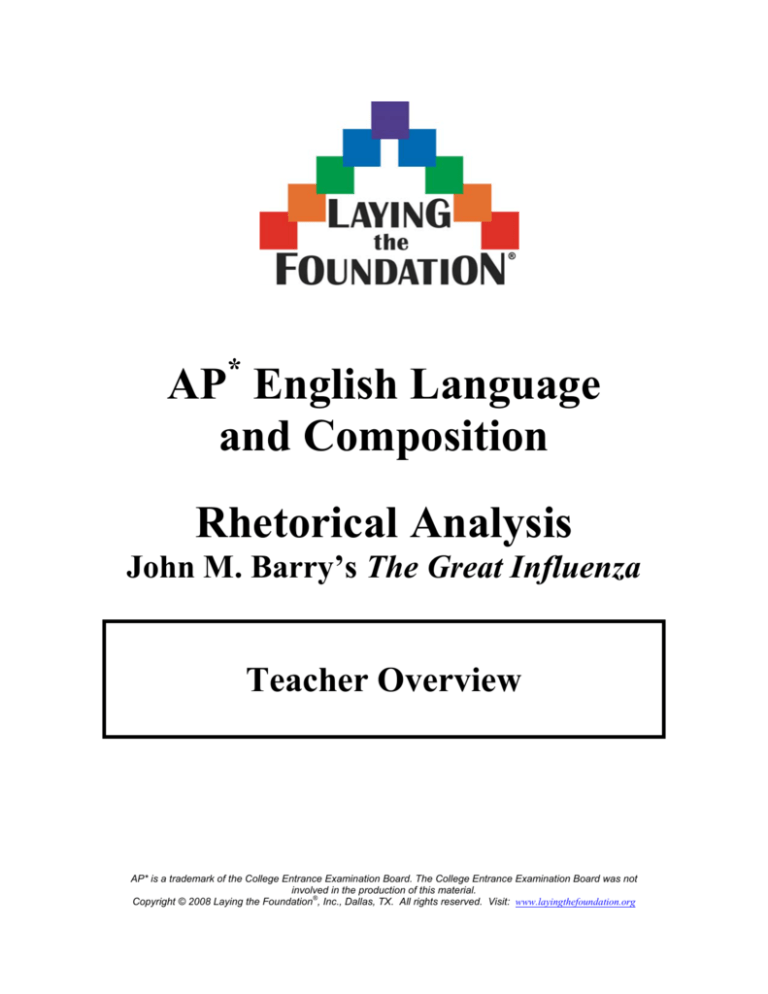
*
AP English Language
and Composition
Rhetorical Analysis
John M. Barry’s The Great Influenza
Teacher Overview
AP* is a trademark of the College Entrance Examination Board. The College Entrance Examination Board was not
involved in the production of this material.
®
Copyright © 2008 Laying the Foundation , Inc., Dallas, TX. All rights reserved. Visit: www.layingthefoundation.org
Rhetorical Analysis
John M. Barry’s The Great Influenza
(References the 2008 AP* Language Exam Question 2)
Teacher Overview
Skill Focus
Remember
Understand
Apply
Analyze
Close Reading
Grammar
Reading Strategies
Annotation
Determining Author’s Purpose
Determining Fact and Opinion
Determining Main Idea
Generalization
Inference
Paraphrase
Prediction
Seminar/Discussion
Summary
Literary Elements
Analogy
Detail
Diction
connotation
denotation
vocabulary
Imagery
Point of View
Rhetorical Shift
Tone
tone determined through
diction, imagery, detail,
point of view, figurative
language, author’s style,
and syntax
tone shift
vocabulary associated with
tone
Figures of Speech (Figurative
Language)
Metaphor
extended/controlling
Paradox
Personification
Pun
Simile
Literary Techniques
Argumentation
emotional appeals
ethical appeals
logical appeals
Syntax Techniques
Antithesis
Juxtaposition
Omission
asyndeton
ellipsis
Parallelism
Polysyndeton
Repetition
anadiplosis
anaphora
epanalepsis
epistrophe
Rhetorical Fragment
Rhetorical Question
Analysis of a Text
Meaning and Effect related to
parts of speech, phrases,
clauses, sentences, and
syntax
Rhetorical Analysis Focused
on Syntax
Evaluate
Create
Composition
Types (modes)
Expository
analytical
cause/effect
classification
definition
Structural Elements
Introduction
thesis
Body
use of commentary
use of evidence
AP* is a trademark of the College Entrance Examination Board. The College Entrance Examination Board was not
involved in the production of this material.
®
Copyright © 2008 Laying the Foundation , Inc., Dallas, TX. All rights reserved. Visit: www.layingthefoundation.org
1
Teacher Overview—The Great Influenza
Materials and Resources: John M. Barry’s book The Great Influenza; copies of the
Student Activity for each student; and copies of the 2008 AP* English Language Exam’s
Question 2.
Past free response questions can be downloaded from College Board’s AP* Central
website at http://apcentral.collegeboard.com/apc/Controller.jpf. Below is a table that
references some recent rhetorical analysis prompts. Pre-twentieth century texts are noted.
Test Year
2008
2008, Form B
2007
2007, Form B
Question #
Question 2
Question 2
Question 2
Question 3
2006
2006
2006, Form B
2005
2005, Form B
2005, Form B
2004
2004
Question 1
Question 2
Question 2
Question 2
Question 1
Question 2
Question 1
Question 3
2004, Form B
2003
2003
Question 2
Question 2
Question 3
2003, Form B
Question 1
®
Prompt
How author characterizes topic
How author develops argument
How author develops argument (19th)
How author praises subject and moves
audience
How author crafts text to reveal view
How author develops argument (19th)
How author develops argument
How author satirizes
How author conveys position (19th)
How author communicates position
How author reveals values/position (18th)
How author uses contrast to develop
position
How author constructs argument
How author persuades (19th)
Compare and contrast how authors
convey positions (19th)
How author persuades (19th)
Copyright © 2008 Laying the Foundation , Inc., Dallas, TX. All rights reserved. Visit: www.layingthefoundation.org
2
Teacher Overview—The Great Influenza
The passage below is from John Barry’s The Great Influenza. On the exam students were
required to analyze how Barry uses rhetorical strategies to define the nature of scientific
inquiry.
Have the students read the passage aloud.
5
10
15
20
25
30
Certainty creates strength. Certainty gives one
something upon which to lean. Uncertainty creates
weakness. Uncertainty makes one tentative if not
fearful, and tentative steps, even when in the right
direction, may not overcome significant obstacles.
To be a scientist requires not only intelligence
and curiosity, but passion, patience, creativity,
self-sufficiency, and courage. It is not the courage
to venture into the unknown. It is the courage to
accept—indeed, embrace—uncertainty. For as
Claude Bernard, the great French physiologist of
the nineteenth century, said, “Science teaches us
to doubt.”
A scientist must accept the fact that all his or her
work, even beliefs, may break apart upon the sharp
edge of a single laboratory finding. And just as
Einstein refused to accept his own theory until his
predictions were tested, one must seek out such
findings. Ultimately a scientist has nothing to believe
in but the process of inquiry. To move forcefully and
aggressively even while uncertain requires a
confidence and strength deeper than physical courage.
All real scientists exist on the frontier. Even the
least ambitious among them deal with the unknown,
if only one step beyond the known. The best among
them move deep into a wilderness region where they
know almost nothing, where the very tools and
techniques needed to clear the wilderness, to bring
order to it, do not exist. There they probe in a
disciplined way. There a single step can take them
through the looking glass into a world that seems
entirely different, and if they are at least partly correct
their probing acts like a crystal to precipitate an order
out of chaos, to create form, structure, and direction.
35 A single step can also take one off a cliff.
40
45
50
55
60
65
In the wilderness the scientist must create . . .
everything. It is grunt work, tedious work that
begins with figuring out what tools one needs and
then making them. A shovel can dig up dirt but
cannot penetrate rock. Would a pick be best, or
would dynamite be better—or would dynamite
be too indiscriminately destructive? If the rock is
impenetrable, if dynamite would destroy what
one is looking for, is there another way of getting
information about what the rock holds? There is a
stream passing over the rock. Would analyzing the
water after it passes over the rock reveal anything
useful? How would one analyze it?
Ultimately, if the researcher succeeds, a flood
of colleagues will pave roads over the path laid,
and those roads will be orderly and straight, taking
an investigator in minutes to a place the pioneer
spent months or years looking for. And the perfect
tool will be available for purchase, just as laboratory
mice can now be ordered from supply houses.
Not all scientific investigators can deal comfortably
with uncertainty, and those who can may not be
creative enough to understand and design the
experiments that will illuminate a subject—to know
both where and how to look. Others may lack the
confidence to persist. Experiments do not simply
work. Regardless of design and preparation,
experiments—especially at the beginning, when one
proceeds by intelligent guesswork—rarely yield the
results desired. An investigator must make them
work. The less known, the more one has to
manipulate and even force experiments to yield an
answer.
The AP* English Language and Composition exam includes one free-response question
that requires students to analyze how an author constructs a text. To succeed in your
analysis, you will be required to demonstrate how technique reveals meaning.
Rhetorical strategies are the tools by which the author creates meaning. You must be
able to identify such strategies as well as explain their significance. As you analyze
®
Copyright © 2008 Laying the Foundation , Inc., Dallas, TX. All rights reserved. Visit: www.layingthefoundation.org
3
Teacher Overview—The Great Influenza
rhetorical strategies, remember what you are looking for: structure, appeals, and devices;
but you must also relate these devices to meaning.
In the exercises below, you will answer questions designed to help “unlock the passage”
in such a way that you can explain how Barry’s techniques define the nature of scientific
inquiry.
5
Certainty creates strength. Certainty gives one
something upon which to lean. Uncertainty creates
weakness. Uncertainty makes one tentative if not
fearful, and tentative steps, even when in the right
direction, may not overcome significant obstacles.
1. Why does Barry begin with a universal truth and delay referring to scientists until
Paragraph 2?
By defining polar opposites, the universal truth intensifies the revelation of the paradox
in the second paragraph—that scientists thrive on uncertainty.
2. What two antithetical concepts occur in this paragraph?
Certainty vs. Uncertainty
3. Examine the syntax of this paragraph and notice the patterns of repetition. What
is the effect of the anaphora in the first four sentences?
The anaphora further solidifies the conventional wisdom that certainty is positive and
uncertainty is negative. (Connotations of strength vs. weakness, supported vs.
unfounded.)
10
To be a scientist requires not only intelligence
and curiosity, but passion, patience, creativity,
self-sufficiency, and courage. It is not the courage
to venture into the unknown. It is the courage to
accept—indeed, embrace—uncertainty. For as
Claude Bernard, the great French physiologist of
the nineteenth century, said, “Science teaches us
to doubt.”
1. Which rhetorical mode is employed in this paragraph?
Classification/Division: the paragraph lists the traits that are required to be a scientist.
®
Copyright © 2008 Laying the Foundation , Inc., Dallas, TX. All rights reserved. Visit: www.layingthefoundation.org
4
Teacher Overview—The Great Influenza
2. Identify the catalog in this paragraph. What purpose is served through this
listing?
“… (I)ntelligence… courage (lines 6-8).” Purpose is to add the less obvious traits to the
two obvious ones (intelligence and curiosity).
3. What purpose do the anaphora and antithesis serve in the second and third
sentences?
The effect is to refine the connotations associated with “courage” through negation of
common concepts. (Not just this but that, too.)
4. To what does the pronoun “it” refer in both sentences?
“It” refers to the type of courage required to be a scientist.
5. What is the effect of the dashes in Line 10?
The dashes interrupt the sentence to clarify and intensify the meaning of “accept.” (Not
just accepting, embracing/clinging to/whole-heartedly accepting/ et cetera.)
6. Which of the appeals does the writer use at the end of this paragraph?
Ethos: the author refers to a historical figure as an authority on the make-up of a
scientist.
15
20
A scientist must accept the fact that all his or her
work, even beliefs, may break apart upon the sharp
edge of a single laboratory finding. And just as
Einstein refused to accept his own theory until his
predictions were tested, one must seek out such
findings. Ultimately a scientist has nothing to believe
in but the process of inquiry. To move forcefully and
aggressively even while uncertain requires a
confidence and strength deeper than physical courage.
1. What is Barry suggesting through his use of the term “A scientist” in the third
paragraph as opposed to the phrase “To be a scientist” in the second paragraph?
Answers may vary. Moves from abstraction to example. “To be a scientist” is
hypothetical—what is required to become one—but “a scientist” is practical—what is
required to exist as a scientist.
®
Copyright © 2008 Laying the Foundation , Inc., Dallas, TX. All rights reserved. Visit: www.layingthefoundation.org
5
Teacher Overview—The Great Influenza
2. Barry uses which figure of speech in the first sentence, and what is its purpose?
Metaphor suggesting the danger of working with the unknown or with something that
may not have been put together well.
3. Why does Barry refer to Einstein in the second sentence?
Appeal to authority and logic: if the renowned scientist didn’t do it, then why should we?
4. What is the implied antecedent of “one” in Line 18?
The hypothetical scientist from line 14.
5. According to Barry, all scientists risk losing their “works” and “even beliefs.”
What, then, is the only thing upon which they must rely?
The scientist is left to “believe in the process of inquiry,” or their methodical collection
of fact and example.
6. What purpose does the infinitive phrase at the beginning of the last sentence of
this paragraph serve?
It signals the summation of the paragraph, that “to move…” is the most important trait.
7. Why does Barry qualify “courage” with the adjective “physical” in the last
sentence of this paragraph?
It further negates the common association of courage with virility and manliness.
25
30
35
All real scientists exist on the frontier. Even the
least ambitious among them deal with the unknown,
if only one step beyond the known. The best among
them move deep into a wilderness region where they
know almost nothing, where the very tools and
techniques needed to clear the wilderness, to bring
order to it, do not exist. There they probe in a
disciplined way. There a single step can take them
through the looking glass into a world that seems
entirely different, and if they are at least partly correct
their probing acts like a crystal to precipitate an order
out of chaos, to create form, structure, and direction.
A single step can also take one off a cliff.
®
Copyright © 2008 Laying the Foundation , Inc., Dallas, TX. All rights reserved. Visit: www.layingthefoundation.org
6
Teacher Overview—The Great Influenza
1. Identify and explain the significance of the extended metaphor in this paragraph.
Frontier, one step beyond the known, wilderness, and cliff all have connotations of the
heroic journey. The idea is that the scientist is like the trailblazer (an idea later
supported in paragraphs 5 and 6) moving into uncharted territory.
2. List examples of repetition and antithesis; and beside each example, comment on
its significance.
Answers may vary.
3. Identify the following:
a. the literary allusion in Line 31
“through the looking glass” from Alice in Wonderland
b. the simile in Line 33
“like a crystal” refers to the way the introduction of a crystal in a solution begins the
process of crystallization
c. the metaphor in Line 35
“off a cliff” suggests pitfalls or other perils of exploration
4. Now, what point does the author make about scientific inquiry through
juxtaposing these three literary devices?
Answers may vary. The Alice allusion suggests going into a world that isn’t real or
doesn’t appear to be real which leads one into trouble. The crystal metaphor suggests
setting off a chain of events beyond the control of the scientist. Going off a cliff suggests
that some steps are terminal. There is a building of intensity in these three figures of
speech suggesting that scientific exploration can be bad if not disastrous, and this is what
a scientist must be prepared to face.
40
45
In the wilderness the scientist must create . . .
everything. It is grunt work, tedious work that
begins with figuring out what tools one needs and
then making them. A shovel can dig up dirt but
cannot penetrate rock. Would a pick be best, or
would dynamite be better—or would dynamite
be too indiscriminately destructive? If the rock is
impenetrable, if dynamite would destroy what
one is looking for, is there another way of getting
information about what the rock holds? There is a
®
Copyright © 2008 Laying the Foundation , Inc., Dallas, TX. All rights reserved. Visit: www.layingthefoundation.org
7
Teacher Overview—The Great Influenza
stream passing over the rock. Would analyzing the
water after it passes over the rock reveal anything
useful? How would one analyze it?
1. Why is the word “everything” set apart from the rest of the sentence?
It uses an ellipsis (which is commonly used to suggest omitted material) to “omit” the
ruminating over everything the scientist must create.
2. What aspect of scientific research does Barry suggest through the term “grunt
work”?
“Grunt work” refers to the preparation necessary to do the work of scientists.
3. Identify the three “tools” in this paragraph and comment on the significance of the
progression from “shovel” to “dynamite.”
Shovel, pick, and dynamite. Each is progressively more destructive and at the same time
useful for excavation.
4. This paragraph contains a series of questions about determining the composition
of rock. Why are these constructions not rhetorical?
A rhetorical question is a device that asks for an answer that is both common knowledge
and extremely obvious. The answer to a rhetorical question is so obvious that the
question need not be asked. The answers to these questions, however, are unknown and
represent the thought process of the scientist.
5. What literary device is employed in the sentences which describe the probing of
rock?
The author chooses to represent the scientist’s thoughts through stream of consciousness.
6. What does the use of this device imply about the nature of scientific inquiry?
Answers may vary. Some students may point out that the answer to one question (or an
observation related to it) produces two more.
50
55
Ultimately, if the researcher succeeds, a flood
of colleagues will pave roads over the path laid,
and those roads will be orderly and straight, taking
an investigator in minutes to a place the pioneer
spent months or years looking for. And the perfect
tool will be available for purchase, just as laboratory
mice can now be ordered from supply houses.
®
Copyright © 2008 Laying the Foundation , Inc., Dallas, TX. All rights reserved. Visit: www.layingthefoundation.org
8
Teacher Overview—The Great Influenza
1. Through what image does the writer link the fifth and sixth paragraphs?
Pioneer/explorer imagery.
2. Explain the meaning of the metaphor “a flood of colleagues.”
Answers may vary. The “flood” after the research has been completed juxtaposes with
the lone scientist going at his research with no guide.
3. Barry repeats the concepts “order,” “pioneer,” and “tool” in this paragraph. This
repetition suggests what as a possible result of diligent scientific inquiry?
Answers may vary. The concepts suggest the progression from new idea to established
truth.
4. Why might Barry specifically refer to “laboratory mice”?
Answers may vary. The mice are a commonly recognized tool of scientific discovery that
must have been, at some point, revolutionary.
60
65
Not all scientific investigators can deal comfortably
with uncertainty, and those who can may not be
creative enough to understand and design the
experiments that will illuminate a subject—to know
both where and how to look. Others may lack the
confidence to persist. Experiments do not simply
work. Regardless of design and preparation,
experiments—especially at the beginning, when one
proceeds by intelligent guesswork—rarely yield the
results desired. An investigator must make them
work. The less known, the more one has to
manipulate and even force experiments to yield an
answer.
1. Which words signal a shift in tone in the last paragraph?
“Not all…” is a negation of previous paragraphs: that which is common to scientists is
not present in all scientists.
2. What are some of the connotative associations of the word “illuminate” in Line
59?
Light of knowledge, discovery, et cetera.
®
Copyright © 2008 Laying the Foundation , Inc., Dallas, TX. All rights reserved. Visit: www.layingthefoundation.org
9
Teacher Overview—The Great Influenza
3. Underline the three sentences which are significantly shorter than the others in
this paragraph. What is the effect of this syntactical variation?
See above for underlined sentences. They are aphoristic assertions that act as
incontrovertible truths based on the premises that Barry has offered. Their brevity
underscores the idea that they are simply true.
4. Barry repeats the words “experiments” and “yield.” In this two-part repetition,
what change in meaning occurs?
The first meaning is to produce as in “yielding a bumper crop.” The second suggests
capitulation or giving up as in “yielding to a superior force.”
5. What audience is Barry addressing in his essay?
Answers will vary. Textual evidence suggests that Barry’s audience is literate enough to
recognize Einstein and Alice in Wonderland, but is not necessarily composed of
scientists. It is likely a general audience of moderately educated readers
6. Briefly describe the tone of this essay. Cite concrete evidence to support your
assertion.
Answers will vary.
Appeals
These close-reading questions focus on linking specific devices to meaning.
Thorough analysis requires that you also address the appeals in order to explain fully the
writer’s purpose. Review the passage and discover areas wherein Barry incorporates the
three appeals to solidify his ideas about the nature of scientific inquiry.
Now write a thesis sentence for an essay in which you analyze how Barry uses
rhetorical strategies to depict the nature of scientific research.
Answers will vary.
®
Copyright © 2008 Laying the Foundation , Inc., Dallas, TX. All rights reserved. Visit: www.layingthefoundation.org
10
Teacher Overview—The Great Influenza
Multiple Choice Questions—Refer to the passage to answer the following:
Give the students about 10 minutes to complete the multiple choice section since they
have already read and annotated the passage. The correct answers have been bolded
and the rationales have been boxed.
1.
The first paragraph includes which of the following?
..I. Anaphora
.II. Antithesis
III. Allegory
(A)
(B)
(C)
(D)
(E)
I only
II only
III only
I and II only
I, II, and III
D. Anaphora occurs in the first and second sentences with the repetition of “Certainty”
and in the third and fourth sentences with the repetition of “Uncertainty.” “Certainty”
and “Uncertainty” are also antithetical. There is no symbolic representation of real-life
events in a fictional tale; therefore, there is no allegory in the first paragraph.
2.
Paragraph 1 suggests that “Uncertainty” creates in a person all of the following
EXCEPT
(A)
feebleness
(B)
hesitancy
(C)
loss of will
(D)
reliance on others
(E)
trepidation
A. “Feebleness” is suggested in the phrase “creates weakness” (lines 2-3).
B. “Hesitancy” is suggested by the word “tentative” (lines 3-4).
C. “Loss of will” is suggested by the phrase “tentative steps” (line 4).
D. Nothing in the paragraph suggests that “Uncertainty” creates reliance on others.
E. Trepidation is suggested by the phrase “makes one tentative if not fearful” (lines 3-4).
®
Copyright © 2008 Laying the Foundation , Inc., Dallas, TX. All rights reserved. Visit: www.layingthefoundation.org
11
Teacher Overview—The Great Influenza
3.
(A)
(B)
(C)
(D)
(E)
In the context of lines 3-4, “tentative” most nearly means
afraid
hesitant
immobile
temporary
weak
B. Hesitant is suggested as the meaning for “tentative” in the phrase “tentative steps,
even when in the right direction, may not overcome significant obstacles” (lines 4-5).
4.
Barry suggests that a scientist must “embrace—uncertainty” (line 10) while at the
same time striving for truth. Herein, he employs which literary device?
(A)
antithesis
(B)
oxymoron
(C)
paradox
(D)
personification
(E)
pun
A. Antithesis involves the use of opposite ideas; there are no opposite ideas in this
construction.
B. Oxymoron is the juxtaposition of contradictory words; “embrace” and “uncertainty”
are not contradictory.
C. A paradox is a seemingly contradictory suggestion which upon investigation proves
true. Scientific inquiry involves searching for truth or reason; therefore, the suggestion
that a scientist also should “embrace—uncertainty” is paradoxical. It is contradictory to
be accepting of the negative result (uncertainty) when the positive result (truth) is what is
actually desired.
D. Personification is the attribution of human-like or animate qualities to non-human or
inanimate entities. There is no personification in this phrase.
E. A pun is play on words. No pun occurs in this phrase.
®
Copyright © 2008 Laying the Foundation , Inc., Dallas, TX. All rights reserved. Visit: www.layingthefoundation.org
12
Teacher Overview—The Great Influenza
5.
The passage as a whole suggests that a scientist must be all of the following
EXCEPT
(A)
daring
(B)
independent
(C)
inquisitive
(D)
intractable
(E)
intrepid
A. Since “All real scientists . . . move deep into a wilderness region where they know
almost nothing” (lines 23-27), a scientist must be daring.
B. Since “[t]o be a scientist requires . . . self-sufficiency” (lines 6-8), a scientist must be
independent.
C. Since “[t]o be a scientist requires . . . curiosity” (lines 6-7), a scientist must be
inquisitive.
D. In the expression “the scientist must create . . . everything” (lines 36-37), Barry
suggests that a scientist must be willing to adapt to circumstances, and “intractable”
suggests an unwillingness to change or adapt.
E. Since inquiry includes “the courage to . . . embrace—uncertainty” (lines 9-10), a
scientist must be intrepid.
6.
(A)
(B)
(C)
(D)
(E)
In Paragraph 2 the repetition of “courage” (lines 8-9) serves to
clarify a concept
continue a process
digress to a related issue
introduce a new idea
provide an analogy
A. Barry clarifies his concept of “courage” by explaining both what it is not and what it
is.
B. There is no process or sequence of events being described.
C. Stays on topic and does not leave it.
D. Again, stays on topic and does not move to a new topic.
E. “Courage” is not being explained through comparison to an analogous idea; rather,
the repetition clarifies the context in which Barry uses “courage.”
®
Copyright © 2008 Laying the Foundation , Inc., Dallas, TX. All rights reserved. Visit: www.layingthefoundation.org
13
Teacher Overview—The Great Influenza
7.
(A)
(B)
(C)
(D)
(E)
The literary device in lines 15-16 (“break apart . . . laboratory finding”) is
antithesis
apostrophe
metaphor
personification
symbol
A. The phrase does not contain opposites.
B. No person or thing is addressed in this construction.
C. Saying that a scientist’s “work, even beliefs, may break apart upon the sharp edge of a
single laboratory finding” is not literal.
D. Nothing is personified in this construction.
E. Nothing in this construction carries the weight of a symbol or stands for something
beyond itself.
8.
(A)
(B)
(C)
(D)
(E)
Lines 30-32 (“There . . . different”) contain which literary device?
allusion
hyperbole
litotes
metonymy
synecdoche
A. The phrase “through the looking glass” is also the title of Lewis Carroll’s novel about
Alice in Wonderland; hence, the allusion.
B. Hyperbole involves exaggeration, and there is no exaggeration in these lines.
C. Litotes involves understatement, and there is no understatement in these lines.
D. Metonymy, a type of metaphor in which an associated concept represents something
else, does not occur in these lines.
E. Synecdoche, a type of metaphor in which the part represents the whole, does not occur
in these lines.
®
Copyright © 2008 Laying the Foundation , Inc., Dallas, TX. All rights reserved. Visit: www.layingthefoundation.org
14
Teacher Overview—The Great Influenza
9.
In the expression “[i]t is grunt work” (line 37), Barry suggests that scientific
inquiry is often
(A)
boring
(B)
dangerous
(C)
dirty
(D)
laborious
(E)
repetitive
A. While scientific inquiry may be boring, it is also possible for highly skilled labor to be
boring; therefore, “boring” alone is not accurate enough to be the answer.
B. There is nothing in the passage to suggest peril to the scientist
C. Like “boring,” “dirty” is not accurate enough on its own.
D. Since grunt is a slang term for a common or unskilled laborer, the phrase “grunt
work” implies that scientific inquiry is boring AND dirty AND repetitive.
E. “Repetitive” on its own does not encompass all of the connotations of the labor as
illustrated in the rest of the paragraph.
10.
The metaphor of “a flood of colleagues [paving] roads over the path laid” (lines
49-50) suggests that subsequent researchers will
(A)
forge new paths for future endeavors
(B)
invent new tools for research
(C)
isolate new areas for exploration
(D)
reap the benefits of others’ labor
(E)
venerate the pioneer for his achievements
A. The quotation suggests that others will follow an already-beaten path, not new paths.
B. While “tools” are mentioned in the previous paragraph with regard to the pioneer, the
“tools” are not new for those who follow.
C. The quotation suggests that others will follow an already-beaten path; therefore, the
areas for exploration are not new.
D. The clauses “pave[d] roads . . . will be orderly and straight” (lines 50-51) and “the
perfect tool will be available for purchase” (lines 53-54), suggest that subsequent
researchers will reap the benefits of others’ labor.
E. The metaphor suggests nothing about veneration of the pioneer.
®
Copyright © 2008 Laying the Foundation , Inc., Dallas, TX. All rights reserved. Visit: www.layingthefoundation.org
15
Teacher Overview—The Great Influenza
11.
Since the controlling metaphor of Barry’s passage compares the scientist to the
frontiersman, the overall tone of this passage is best described as
(A)
elegiac
(B)
indifferent
(C)
maudlin
(D)
nostalgic
(E)
optimistic
A. Elegiac suggests mourning for something that is lost; Barry does not lament the loss of
the frontier.
B. Barry is not indifferent to the situation of the scientist.
C. There is nothing sentimental in this passage.
D. Barry is not looking back fondly to the days of the frontier.
E. The frontiersman in American myth suggests an optimistic willingness to confront the
unknown.
12.
(A)
(B)
(C)
(D)
(E)
The intended audience for this essay is most probably
college students
general readers
professional historians
research scientists
science teachers
B. The absence of overly complex syntax, specialized terminology, and esoteric ideas
indicates that the passage is intended for a general readership rather than a specialized
group.
®
Copyright © 2008 Laying the Foundation , Inc., Dallas, TX. All rights reserved. Visit: www.layingthefoundation.org
16

